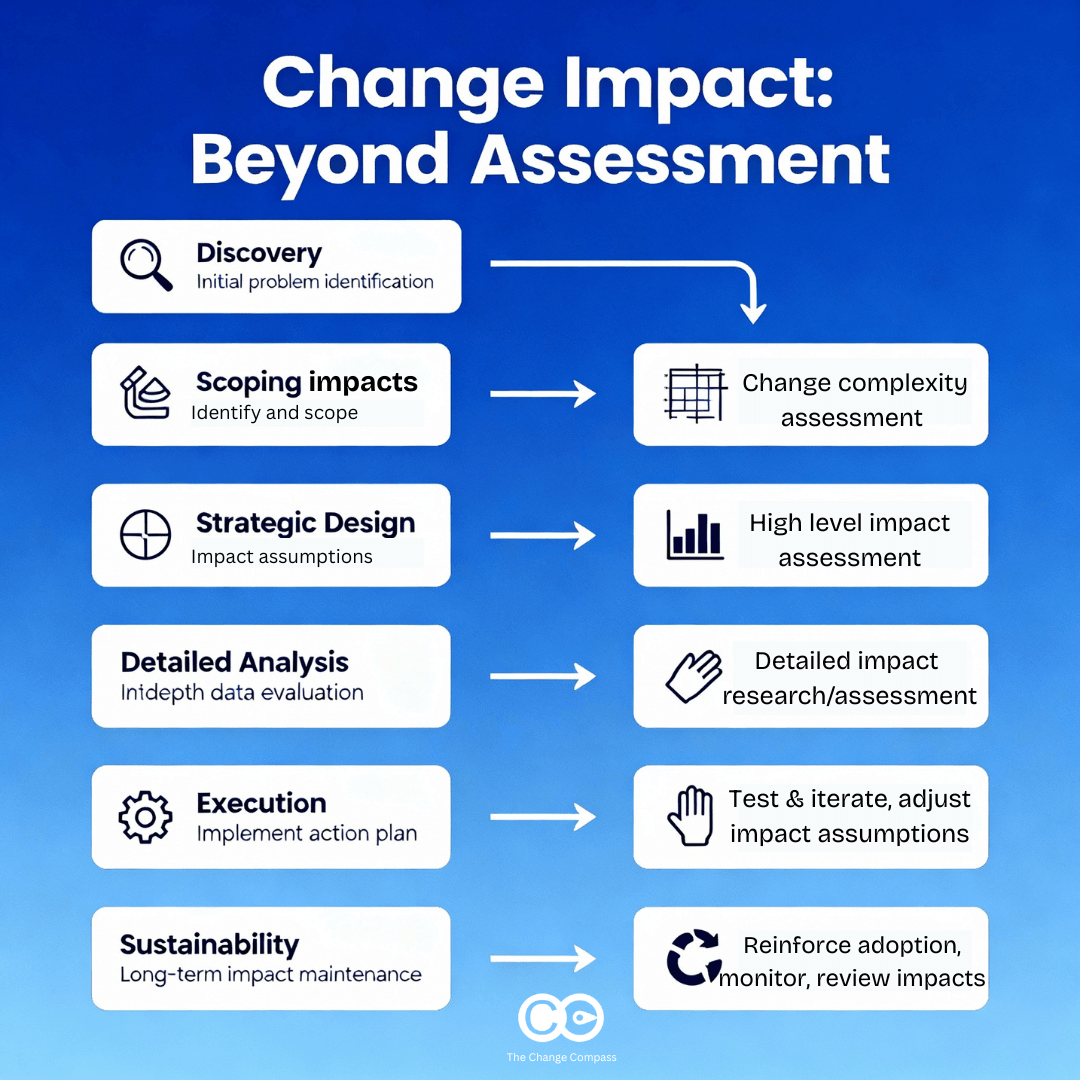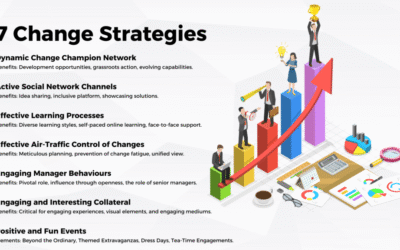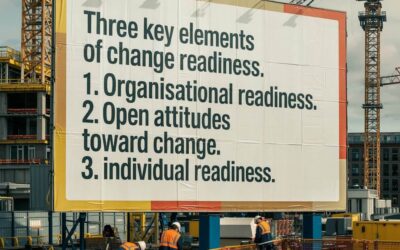Most change practitioners fall into the trap of thinking that change impact work begins and ends with the change impact assessment – that single exercise conducted before the midway of a project to determine who’s affected and how. This narrow view fundamentally misunderstands the role of impact work in successful change management. Change impact assessment isn’t a one-off activity; it’s the backbone that runs through every phase of your change initiative, from initial scoping through to post-implementation adoption. Incorrect change impact assumptions means your change approach is incorrect and you may never reach adoption.
The reality is that understanding and managing change impact is an evolving change management process that should inform every decision you make throughout the lifecycle of change. It’s about building a comprehensive picture of how your initiative will affect people, processes, and the broader organisational ecosystem – and then using that understanding to craft interventions that actually work.
When we limit ourselves to a single impact assessment, we’re essentially taking a snapshot of a moving picture. Change impact assessment is dynamic, and our change management approach needs to be equally adaptive. This means starting impact work from the moment we begin understanding what the change entails, and continuing through to ensuring sustainable adoption long after go-live.
Understanding change impact as continuous discovery
Early discovery: mapping the unknown
The journey begins much earlier than most practitioners realise in any effective change management framework. As soon as you start gathering initial information about the proposed change, you’re already conducting preliminary change assessment work. This early phase is about understanding the fundamental nature of what’s changing and beginning to piece together who might be affected.
During these initial conversations with stakeholders, you’re not just collecting requirements – you’re starting to build a picture of potential impacts through systematic change analysis. When a sponsor describes needing to “improve our customer service response times,” you’re already thinking about which teams handle customer enquiries, what systems they use, and how their daily work might shift. This isn’t formal assessment yet; it’s intelligent reconnaissance that will inform everything that follows.
The key at this stage is to remain curious and avoid jumping to conclusions. This foundational change management activity helps you understand not just what’s changing, but why it’s changing and what success looks like. This understanding will shape how you approach every subsequent phase of impact work and serves as a critical component of managing change effectively.
Scoping the scale: from broad strokes to focused planning
As you gather more information through your change management process, you can begin to scope out the size and complexity of the change at a high level. This is where impact work transitions from discovery to strategic planning within your broader change management methodology. You’re now able to make informed decisions about the resources required for change management and how different stakeholder groups will need to be involved.
This phase is crucial because it directly influences your change management approach and resource allocation. A change initiative that affects five people in one department requires a fundamentally different methodology to one that touches every business unit across multiple locations. Understanding the levels of change helps you determine whether you need a small, focused change team or a comprehensive change network with champions across the organisation.
The impact scoping also informs critical decisions about timing and sequencing within your enterprise change management strategy. If your change affects multiple interconnected systems or processes, you need to understand these dependencies early enough to plan a logical rollout sequence that minimises disruption and maximises change success.
Developing your strategic impact lens
High-level impact assessment for approach design
With sufficient detail gathered, you can conduct a more structured high-level change assessment. This forms the foundation of your change management approach and helps you make strategic decisions about how to manage the transformation using proven change management techniques.
This assessment goes beyond simply identifying who’s affected. It examines the nature and depth of impacts across different dimensions: how people’s roles will change, what new skills they’ll need, how processes will be modified, what systems will be different, and how the organisational structure might shift. Each of these dimensions requires different types of change management activities and represents various levels of change management intervention.
The strategic value of this phase lies in its ability to inform your overall change management framework. If your assessment reveals that the change primarily affects processes rather than technology, your approach will emphasise process training and workflow redesign. If it shows significant cultural shifts are required through behavioural change management, you’ll need to plan for longer timelines and more intensive change management leadership engagement.
Detailed impact analysis: the precision phase
Eventually, you have sufficient detail to conduct a comprehensive change impact assessment. This is the phase most practitioners are familiar with, but it’s important to understand that this detailed analysis builds on all the previous impact work rather than starting from scratch as part of implementing change management effectively.
The detailed assessment examines specific impacts at the individual and team level. It identifies exactly how each role will change, what new competencies people will need, and what barriers they might face in adopting new ways of working. This granular understanding enables you to design targeted interventions that address specific needs rather than generic solutions, representing change management best practices in action.
This phase also involves creating detailed stakeholder maps that go beyond simple influence-interest matrices. You’re looking at change readiness levels, change capacity, potential sources of resistance, and opportunities for leveraging natural change champions within the organisation as part of your broader change management strategy.
Seeing the whole picture: landscape assessment
Understanding the broader change ecosystem
One of the most overlooked aspects of impact work is understanding the broader change landscape that your stakeholders are navigating. To truly take a human-centric view of managing change, you need to see the experience from the perspective of impacted individuals and teams within change in organisations.
This means mapping out all the other change initiatives and business-as-usual challenges that your stakeholders are dealing with simultaneously. Are they also implementing a new performance management system? Have they just been through a restructure? Are they facing increased compliance requirements? All of these factors influence their change readiness and capacity to absorb and adapt to your change.
The landscape assessment often reveals insights that fundamentally alter your change management approach. You might discover that your planned June rollout coincides with the busiest period for your target audience, or that they’re already experiencing change saturation with three other major initiatives. This intelligence enables you to make informed decisions about prioritisation, sequencing, and resource allocation.
Using the right change metrics to assess impacts within the change landscape or within your change initiative is critical to help you piece together a picture of what the impacts mean and if there are risks and opportunities due to impacts within your overall delivery.
Strategic decision-making from landscape insights
The landscape assessment doesn’t just inform timing decisions; it shapes your entire change management framework. If you discover that your stakeholders are experiencing change fatigue, you might decide to emphasise the benefits more strongly or invest more heavily in leadership support. If you find that they’re excited about innovation but wary of technology, you can frame your change accordingly using appropriate analogy or reference points.
This broader view also helps you identify risks and opportunities that aren’t visible when looking at your change initiative in isolation. Perhaps another initiative has already built change capability in your target audience that you can leverage, or maybe there’s a risk of conflicting messages that you need to coordinate through effective change monitoring.
The landscape assessment should inform decisions about whether to proceed as planned, adjust timing, or modify your approach. Sometimes it reveals that the organisation simply doesn’t have the capacity for your change right now, and the most strategic decision is to delay or rescope the initiative based on change readiness factors.
Testing and adapting: impact work in execution
Pilot testing your impact assumptions
When you move into execution, your change impact assessment work shifts from assessment to validation through systematic change management tracking. Your pilot implementation becomes a critical test of all the assumptions you’ve made about how the change will affect people and operations.
This is where the theoretical meets the practical in your change management process. You might have assessed that people will need two days of training to become proficient with a new system, but the pilot reveals they actually need four days plus ongoing coaching. Your impact assessment predicted resistance from middle managers, but it turns out they’re actually champions once they understand the benefits.
The pilot phase is your opportunity to gather real-world evidence about the accuracy of your impact predictions and the effectiveness of your interventions through measuring change management outcomes. This evidence should directly feed into refinements of your rollout strategy and overall change management methodology.
Adapting based on stakeholder feedback
Effective change impact assessment work during execution involves creating robust feedback loops that allow you to continuously refine your understanding and approach through change management monitoring. This means going beyond simple satisfaction surveys to gather meaningful insights about how people are experiencing the change.
Are your readiness activities actually preparing people for the level of change and nature of the impacts they’re experiencing? Are people confident about using new processes, or are they struggling with aspects you hadn’t anticipated in your change analysis? Is the support you’re providing sufficient, or do they need additional resources or different types of assistance?
This ongoing change assessment during execution often reveals gaps in your original analysis or changes in the organisational context that require adjustment. The key is to remain agile and responsive while maintaining the overall integrity of your change management approach.
Sustaining change through continued impact focus
Maximising adoption through ongoing assessment
Even after go-live, change impact assessment work continues to play a crucial role in ensuring successful adoption and measuring change management effectiveness. This phase focuses on validating whether your impact assumptions were correct and whether your interventions are achieving the desired behavioural changes.
This is where you assess whether people are actually doing what they need to do differently, not just whether they know how to do it. Are they using new systems as intended? Are they following revised processes? Are they demonstrating the mindset shifts that the change requires? This ongoing change management tracking helps ensure sustainable change success.
The adoption phase often reveals the difference between compliance and genuine adoption through measuring change outcomes. People might be going through the motions of change without truly embracing new ways of working. This insight helps you determine whether additional change management activities are needed to reinforce desired behaviours and fully embed the change.
Reinforcement and continuous improvement
The final phase of impact work involves ensuring that changes stick and continue to deliver value over time through systematic change management monitoring. This requires ongoing assessment of whether the organisation is sustaining new behaviours and achieving the intended change management objectives.
This phase might reveal that while initial adoption was successful, people are gradually reverting to old ways of working, or that new challenges have emerged that require additional support. Understanding these longer-term impacts enables you to design reinforcement mechanisms that ensure lasting change management success.
The sustainability phase also provides valuable insights for future change initiatives. What worked well in terms of impact management? What would you do differently next time? How can the organisation build on the change capability it has developed through this experience as part of enterprise change management maturity?
Making impact work practical
Building impact work into your change methodology
The shift from treating impact as an activity to embedding it as a continuous process requires some practical adjustments to how you structure change management activities. Rather than having a single “impact assessment” deliverable, consider how impact considerations can be woven throughout your change management framework.
This might mean adding impact review checkpoints to every phase of your project, ensuring that impact considerations inform key decision points, and creating mechanisms for continuously updating your understanding based on new information. This represents one of the key change management best practices for modern organisations.
Developing organisational impact capability
For organisations that undergo frequent change, developing systematic capability around impact work pays dividends as part of enterprise change management maturity. This involves training change managers in comprehensive impact methodologies, creating templates and tools that support continuous change assessment, and building organisational memory about what works.
The most mature organisations develop integrated approaches that combine impact work with broader change portfolio management, ensuring that individual change initiatives are planned and executed with full awareness of the broader organisational context and change in organisations dynamics.
The shift to treating change impact assessment as continuous, strategic work rather than a discrete assessment activity represents a fundamental maturation in change management practice. It recognises that change is complex, dynamic, and inherently human – and that our change management approaches need to reflect this reality.
By embedding impact work throughout the change management process, we create more responsive, effective change management frameworks that better serve both change management objectives and the people who make change happen. This holistic approach doesn’t just improve change success rates; it builds organisational capability for navigating an increasingly complex and change-intensive business environment.
The organisations that master this integrated approach to change impact assessment will find themselves better equipped to handle the accelerating pace of change while maintaining focus on the human experience that ultimately determines change management success or failure. Change impact assessment work isn’t just about assessment – it’s about building the intelligence, logic and adaptability that enables sustainable transformation through effective managing change practices.






